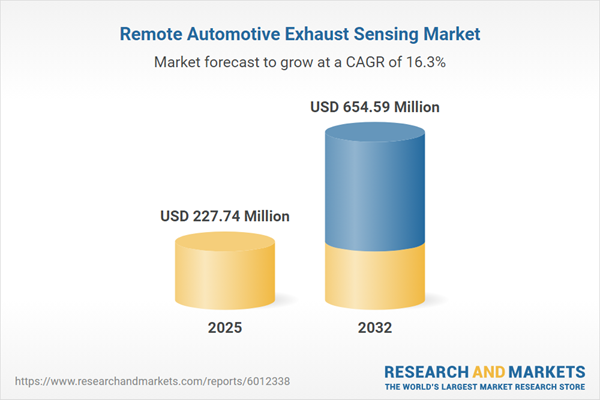Speak directly to the analyst to clarify any post sales queries you may have.
The Remote Automotive Exhaust Sensing Market is rapidly evolving, driven by the ongoing need for emissions compliance, operational efficiency, and advanced fleet management solutions. Senior decision-makers are turning to innovative remote sensing technologies to navigate complex fleet environments and remain competitive in an era of stringent regulatory requirements.
Market Snapshot: Remote Automotive Exhaust Sensing Market Growth
The Remote Automotive Exhaust Sensing Market is experiencing strong expansion, with its size advancing from USD 196.09 million in 2024 to USD 227.74 million in 2025 and a projection of USD 654.59 million by 2032. This represents a robust compound annual growth rate (CAGR) of 16.26%. Market momentum is underpinned by shifting regulatory landscapes, increased demand for real-time emission measurement, and rapid technological innovation. Both established and emerging markets are accelerating adoption, and organizations implementing integrated sensor analytics, advanced connectivity, and data-driven fleet management are positioning themselves to meet regulatory standards, enhance operational agility, and ensure business resilience in a fast-changing environment.
Scope & Segmentation of the Remote Automotive Exhaust Sensing Market
- Sensor Type: Electrochemical sensors offer precise, stable monitoring for compliance; non-dispersive infrared models support standardized emissions testing; optical and photoionization units enable instant response to detected emissions for prompt regulatory action.
- Connectivity Type: Wired systems deliver secure and centralized emission data reporting; wireless platforms, including Bluetooth, Wi-Fi, and cellular options, allow remote diagnostics and data access for distributed or mobile fleets.
- Application: Real-time diagnostics minimize unplanned downtime and expedite emissions reporting; onboard monitoring platforms ensure continuous regulatory alignment; tunnel air quality monitors help evaluate transit environments, supporting broad compliance strategies.
- Vehicle Type: Commercial vehicle applications are designed for optimized sensor integration in trucks and buses, while solutions for passenger vehicles enable coverage across both new and legacy fleet assets.
- End User: OEM integrations provide compliance solutions at assembly, whereas aftermarket upgrades enable existing fleets to meet new standards without complete vehicle replacement.
- Region: Americas are focusing on urban fleet modernization and infrastructure adaptation; Europe’s strong regulatory environment fosters high adoption; Middle East & Africa see investment in emission reduction amid diverse economic conditions; Asia-Pacific experiences adoption growth as urban mobility and regulations change rapidly.
- Company Coverage: Notable industry leaders such as Robert Bosch GmbH, Denso Corporation, Continental AG, Vitesco Technologies GmbH, Hitachi Ltd., Sensata Technologies, Marelli Holdings, and Infineon Technologies AG are emphasizing sensor miniaturization and portfolio expansion to address the varying requirements of business operators and regulatory agencies.
Key Takeaways for Senior Decision-Makers
- Remote exhaust sensing technologies enable organizations to rapidly assess emissions data, promoting agility in compliance management and accelerating adaptation to regulatory shifts regionally and globally.
- Cloud-based and wireless solutions streamline fleet diagnostic workflow, allowing seamless data handling and oversight for large, distributed vehicle operations.
- The transition toward electrified and hybrid vehicle fleets is increasing the relevance of adaptable sensor systems, ensuring that emission reporting infrastructure remains up to date as vehicle technologies evolve.
- Continued advancements in sensor miniaturization and design facilitate predictive maintenance, supporting reliability and efficiency by reducing instances of unplanned service interruption.
- Both OEM and retrofit solutions provide organizations with the flexibility to implement compliance upgrades according to fleet age, size, and strategic objectives, addressing a broad range of operational needs.
- Engagement with regional regulators and early adoption of compliance technologies assist in reducing disruption and maintaining consistent levels of service and market competitiveness as rules evolve.
Tariff Impact: Navigating Supply Chains and Cost Adjustments
Recent changes in U.S. tariff policy are driving manufacturers to reinforce their supply networks and diversify sourcing strategies. Increased reliance on regional assembly and supplier expansion supports greater logistical resilience and helps control cost fluctuations, thereby offering business partners improved delivery reliability in uncertain global trade environments.
Methodology & Data Sources
This market analysis is informed by direct contributions from sensor development engineers, automotive industry executives, and regulatory leaders. Additional perspective is provided by reviews of international standards, participation in major industry forums, and assessments of current legislative updates to capture changing market dynamics.
Why This Report Matters
- Procurement and compliance professionals gain actionable guidance for regulatory alignment and enhanced planning efficiency.
- Senior managers are equipped with relevant insights into technology trends and supplier evaluation, supporting timely and informed strategy adjustments.
- Segmented results enable targeted tactics for regional compliance and modernization, strengthening organizational risk management and operational flexibility.
Conclusion
This report delivers segmented analysis and practical guidance for senior leaders managing fleet emissions, equipping organizations to anticipate compliance needs and sustain competitive operations amid industry change.
Additional Product Information:
- Purchase of this report includes 1 year online access with quarterly updates.
- This report can be updated on request. Please contact our Customer Experience team using the Ask a Question widget on our website.
Table of Contents
3. Executive Summary
4. Market Overview
7. Cumulative Impact of Artificial Intelligence 2025
Companies Mentioned
The companies profiled in this Remote Automotive Exhaust Sensing market report include:- Robert Bosch GmbH
- Denso Corporation
- Continental AG
- Vitesco Technologies GmbH
- Hitachi Ltd.
- Sensata Technologies, Inc.
- Marelli Holdings Co., Ltd.
- Infineon Technologies AG
Table Information
| Report Attribute | Details |
|---|---|
| No. of Pages | 184 |
| Published | October 2025 |
| Forecast Period | 2025 - 2032 |
| Estimated Market Value ( USD | $ 227.74 Million |
| Forecasted Market Value ( USD | $ 654.59 Million |
| Compound Annual Growth Rate | 16.2% |
| Regions Covered | Global |
| No. of Companies Mentioned | 9 |









